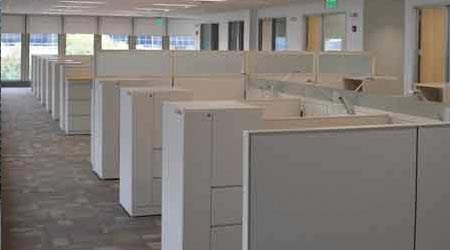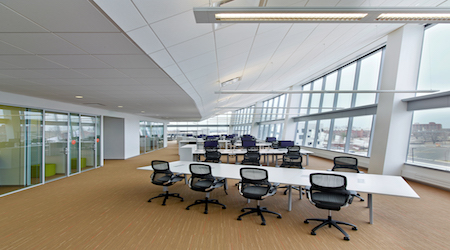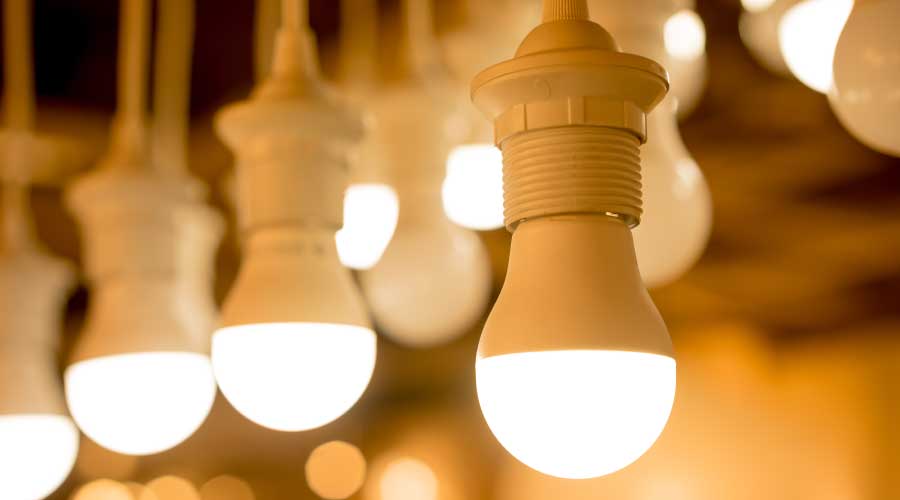High-Performance Lighting Means Balancing Budget with Quality
Part 2 of a 3-part article on how efficiency is only the start in high-performance lighting.
Experts seem to agree that high-performance lighting challenges generally require juggling budgetary constraints with lighting quality and illuminance levels. What’s more, in some cases, “the technology can seem complicated” to the facility manager, says Taylor.
Hay admits some compromises also may occur in the actual design elements. For example, a number of decorative fixture options are not yet available for LEDs. “Candelabra lamps just came out,” she observes. “So achieving a wow factor or sparkle in certain spaces can be challenging, particularly when you are trying to find decorative elements.”
In vintage building retrofits, lofty 14- or even 16-foot ceilings also pose lighting design challenges, explains Hay. “When spaces do not have the more conventional 9-foot ceilings, they require different lighting solutions, because they are limited to the same code requirements.”
Mesh agrees that lighting retrofits can be challenging. “In new construction, we are virtually unlimited in high-performance options,” he says. “But in existing space, it’s sometimes harder to weave in.”
Grappling with Costs
Like many newer technologies, high-performance lighting may have a higher first cost. But there are significant savings benefits when facility managers are willing to look several years down the road.
“While adding proper daylighting can sometimes be almost free, in reality skylights cost as much as or more than a good electric lighting system, and you will need both,” says Benya. On top of that, the facility manager has to add on networked lighting controls, shading, and shielding as well as the premium cost of high-end luminaires.
But high-performance lighting can offer significant energy costs savings compared to conventional code-compliant design. “In locations with high energy rates, the savings from a good design could be as much as 50 cents per square foot per year,” says Benya.
What’s more, Hay points out, the cost premium for high-performance lighting is diminishing, with payback periods ranging from “a couple years to five or six years.” Lamp prices are still higher than less efficient options, but are dropping.
Another element to consider is that new luminaires may have operating lifetimes of 22 years or more. So facility operations and relamping costs are significantly lower than older models.

Caption: The use of LEDs in this open office provides 40 foot-candles at the workplane with an overall lighting power density 23 percent better than the International Energy Conservation Code’s 2009 allowance, even with limited daylight harvesting in the space. Photo courtesy of Jered E. Widmer, The Lighting Practice.
Mesh notes that many high-performance lighting elements can achieve paybacks in one to three years. However, some items such as larger, comprehensive control systems “are new to the market and have a greater payback period, because they had high development costs.”
Although prices are currently somewhat limiting, Mesh expects those prices to drop dramatically relatively quickly. “Part of the reason is that the new technologies are essentially electronic components,” Mesh explains. “Look at the rapid pricing change in chips, laptops, and other electronic elements. They came down very quickly, once the demand allowed for mass production.”
Subtle Differences
For most building occupants, high-performance lighting won’t look that much different than traditional lighting. “You might notice fixtures are off when daylight is being harvested,” says Taylor. “Or they may come on when you enter the room and automatically turn off when you leave.”
Benya thinks most people would not notice much difference in the lighting fixtures themselves. “What you might notice if you look closely will be better-designed windows and skylightings, automated shades, and attractive lighting controls that allow dimming.
“Perhaps some day there will be new styles and technologies that look much different, but I’ll bet that common 2-by-4-foot lens troffers with LEDs, LED downlights, and LED high-bay lighting won’t look too much different than 10 years ago,” observes Benya. “They will just work much better.”
Rita Tatum, a contributing editor for Building Operating Management, has more than 30 years of experience covering facility design and technology.
Email questions to edward.sullivan@tradepress.com.
Related Topics:















